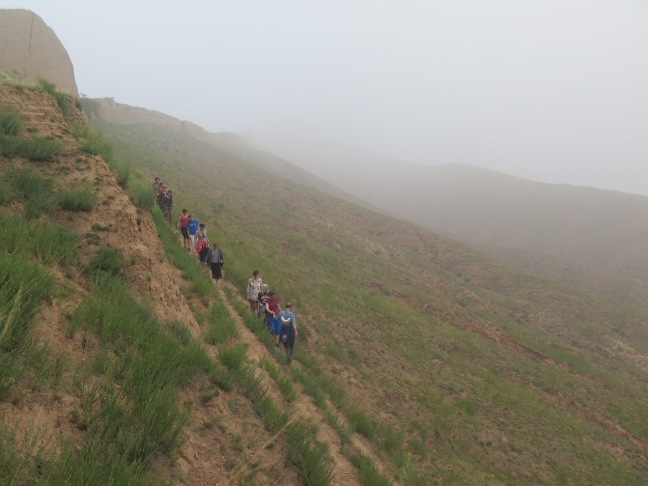
“I think it’s like the French, ce soir…”
“Yes, but with a ‘ts’ sound in front…”
Seven of us stood in the bathroom line at a Tibetan restaurant practicing our Chinese.
“Like swa, from swan.”
A family sat in the adjacent dining room taking us in with smiles. Other than us the place was stone quiet.
“Cèsuǒ…Cè…suǒ,” Yeah, that’s right. “Cèsuǒ, Cèsuǒ!” We chanted the word repeatedly with increasing vigor, bobbing our heads in unison, feeling good we were getting it.
Then it dawned on me. “Um, you guys realize we’re standing here shouting toilet in Chinese?”
The group has had countless fun moments. And in the coming days we would test the mettle of our collective with a 4am hike to a remote part of the Great Wall, a night sleeping shoulder-to-shoulder on a kang stove in a rural homestay and a 1,000 step descent into a coal mine – each of us dressed in full miner regalia. We’d end this leg of the trip on a night train heavy with the odors of old socks and ripe underarms.
“Jim, it’s 4am.” John was sleeping next to me on the kang, a large flat platform built above a fire chamber used for cooking and sleeping. We are in Hebei province outside of Beijing. I stumbled to the outdoor ce soir and balanced precipitously on the edge of a platform above the humanure pile likely used to fertilize the vegetables we’d eaten the night before. A small dog on a short leash yapped incessantly. Above me apricots appeared in the dim light from my phone amidst the sounds of the faculty gathering. We walked single file through town as we began our ascent. Stepping lightly through corn fields, with the morning dew dampening our shoes, we soon bordered tall earthen masses – preface to the Great Wall ahead.
Mr. Zhou led the country leg of our tour. A local of these parts, Mr. Zhou knew where to eat, sleep and find palatable bathrooms for Americans. Or not. Depending. Tram and Grace, our Beijing leaders, brought up the rear. I hung at the back to get shots of the growing wall in front of us. The grade steepened and little puffs of red dust rose with each person’s footfall as morning began to lighten the sky.
“This part of the wall is Ming dynasty. Bricks were made from rammed earth in wooden forms,” Joyce, our go-to colleague on Chinese history. “Many workers died and were buried in the wall.” The towers grow massive and we clamber up a makeshift path to the ridge. Steep drops greet us on both sides and the ground is peppered with goat droppings. Further down the path we stop and survey the valley below. A line of us join Jennifer M. in a sun salutation. The sun part of the sunrise, however, was masked by an insistent white fog that had insinuated itself into every cranny of the landscape. These morning mists never burned off. It was straight up pollution. Even out here in the countryside.

Despite such negatives, it’s hard not to love China. Buried in its contrasts of rich and poor, modesty and brusqueness, openness and control, the heart of China beats warmly and loudly.
The people are wonderful, even when they’re not. The food is delicious, even when it isn’t. The government is benevolent, though it still represses. The whole thing works – but you can’t believe it possibly could.
Sorting through all the forces of China could take many lifetimes. For now, we were content to stand atop the mighty border fence of yore, thinking of emperors and workers and a billion clay bricks and a billion Chinese and a billion beautiful feelings for the crazy-strange magical land spread out before us.
More soon.

Will Donald build a mighty border fence like this one?
LikeLike